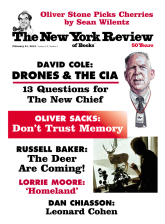In response to:
The Gentle Genius from the January 10, 2013 issue
To the Editors:
For readers who have noted that my review of the “Late Raphael” exhibition [NYR, January 10] refers to the “apocalyptic beasts” in Raphael’s The Vision of Ezekiel and that the caption to the tapestry version of that painting on page 63 identifies them as “symbols of the evangelists”: the beasts in Raphael’s painting are straight out of Ezekiel 1. Medieval artists assimilated them to the four evangelists. Raphael was working with Hebrew texts in the second decade of the sixteenth century with the help of his friend Egidio da Viterbo, who read Hebrew well, and because Raphael painted the prophet Isaiah in Egidio’s church of Sant’Agostino circa 1512, I assume that this Ezekiel is likewise a meditation on the Hebrew Bible.
But meanings are layered in early-sixteenth-century Rome; another reader has noted that I discuss the Tiber valley rather than the Valley of Chebar (Ezekiel 1:1). In the simplest visual terms, Raphael was portraying Ezekiel’s vision in a landscape he knew well, the Tiber valley, but to Egidio da Viterbo and other contemporary preachers, Italy was the New Israel and Rome the New Jerusalem, and the Tiber valley might therefore be seen as a new Valley of Chebar.
Ingrid D. Rowland
Rome, Italy
This Issue
February 21, 2013
Speak, Memory
13 Questions for John O. Brennan
Double Agents in Love



